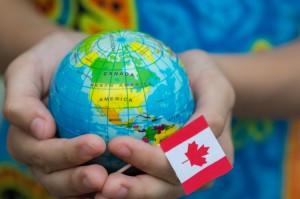Government of Canada Plans on Admitting Record Numbers of new Immigrants in 2016
 The Liberal government of Canada plans on welcoming up to 305,000 new permanent residents this year — the highest projected immigration level in decades, and around a seven percent increase on the 2015 plan.
The Liberal government of Canada plans on welcoming up to 305,000 new permanent residents this year — the highest projected immigration level in decades, and around a seven percent increase on the 2015 plan.
The government provided details in its 2016 Immigration Levels Plan, which was published on Tuesday, March 8. The increase in immigration numbers will be primarily through family sponsorship and refugee settlement programs, though more than half of all newcomers will arrive through economic immigration programs. The target mark of 160,600 people in economic programs is in line with admissions through those programs over recent years, even if the target itself is slightly lower than last year.
The numbers of refugees to be accepted in 2016 will be around double the number that was targeted for 2015. Canada's Minister of Immigration, Refugees and Citizenship (IRCC, formerly known as CIC), John McCallum, has stated that his department aims to speed up processing times for family class immigration, economic immigrants and refugee claimants by applying the lessons it learned from bringing 25,000 Syrian refugees to Canada over recent months.
Growing the country
The 2016 plan marks an increase of about 20,000 in the total number of new permanent residents to be admitted, relative to 2015. Indeed, the 2015 plan also saw an increase of 20,000 over the previous year. Consequently, the 2016 target is about 40,000 higher than that for 2014.
Minister McCallum said the plan is grounded in Canada’s tradition of being a welcoming and generous country. “We will be able to welcome more people to Canada,” he said at a news conference in Brampton, Ontario.
“It [the plan] outlines a significant shift in immigration policy towards reuniting more families, building our economy and upholding Canada’s humanitarian traditions to resettle refugees and offer protection to those in need.”
The plan calls for between 280,000 and 305,000 permanent residents to be allowed into Canada in 2016. Calling it the country’s highest targeted number of new immigrants in modern times, McCallum said the government’s goal is to “bring in immigrants who wish to build a better Canada."
The plan is supposed to be tabled each November for the following year, but the one for 2016 was delayed by the general election and change of government around that time last year.
Breaking down the numbers
Immigrants to Canada arrive through one of three broad categories: Economic, Family Class, and Refugee and Humanitarian.
Immigration Category |
2016 Target |
2015 Target |
Percentage Difference, 2015 to 2016 |
Economic Total |
160,600 |
181,300 |
-11.4% |
Family Total |
80,000 |
68,000 |
+17.6% |
Refugee and Humanitarian |
59,400 |
29,900 |
+98.6% |
Overall |
300,000 |
279,200 |
+7.4% |
To view a full breakdown of the various immigration programs under each of these categories, click here.
Economic immigration to Canada
Economic immigration supports Canada’s long-term economic growth while improving global competitiveness and strengthening communities across the country. Experienced professionals, tradespersons, businesspersons, and caregivers make up the bulk of all new immigrants to Canada. In making the decision to develop their careers in Canada, these newcomers help to create jobs and growth in new and existing industries.
Canada is seeking to attract workers who will succeed in the Canadian labour market and integrate smoothly into Canadian society. Economic immigration, which is based on an individual’s skills and experience, presents an opportunity for foreign workers and their families to come to Canada through a variety of programs. Of the immigrants to be selected for permanent residence in Canada in 2016, between 151,200 and 162,400 are expected to be economic immigrants.
Economic Immigration Program |
2016 Levels Plan Target |
Federal Economic – High Skilled* |
58,400 |
Federal Economic – Caregivers |
22,000 |
Federal Economic – Business |
800 |
Provincial Nominee Program |
47,800 |
Quebec Skilled Worker |
26,200 |
Quebec Business |
5,400 |
Overall |
160,600 |
Reuniting more families in Canada
Immigration Minister John McCallum stated that a “significant shift” in the federal government’s immigration policy was aimed at reuniting more families in Canada.
The government says it will increase admissions for sponsored spouses, partners and dependents, and help reduce application processing times by allocating additional resources and improving methods used within the department. Under the Family Class programs, the government aims to welcome 60,000 sponsored spouses, partners and children, as well as 20,000 parents and grandparents, by the end of the year.
McCallum said that family reunification backlogs will be reduced as more individuals are admitted to the country. IRCC is doubling the number of sponsorship applications for parents and grandparents that it will accept for processing to 10,000 a year. A total of 20,000 admissions are planned under the Parent and Grandparent Program, and by the end of 2016 it is expected that the backlog inventory will be reduced by approximately 15 percent.
Family Class |
2016 Levels Plan Target |
Spouses, Partners and Children |
60,000 |
Parents and Grandparents |
20,000 |
Overall |
80,000 |
To find out if you or your spouse, partner or dependent(s) is eligible for sponsorship under the Family Class, please fill out a free online assessment. To find out if your or your To find out if you or your family members are eligible for the Parent and Grandparent Program (PGP), please fill out a free parental sponsorship assessment today.
Canada, a safe haven
In the short time the Liberal government has been in office, its signature move on the immigration file has been with respect to the increased and expedited settlement of refugees, particularly those fleeing the war in Syria. Though the government recently met its target to welcome 25,000 such persons by the end of February, 2016, it plans on welcoming additional numbers of refugees over the course of the year.
Minister McCallum has urged Canadians to welcome the new refugees with “open arms” and help them find homes, jobs and adjust to their new lives in Canada. By and large, the Canadian public has received the refugees positively.
The refugee settlement program is divided into those who arrive with government assistance and those who are sponsored privately, as well as a smaller number who arrive via a program that blends the two. Further, protected persons already in Canada and their families abroad, as well as individuals applying for permanent residence on humanitarian and compassionate grounds, come under this broad category.
Immigration Program |
2016 Levels Plan Target |
Government-Assisted Refugees |
24,600 |
Privately Sponsored Refugees |
17,800 |
Blended Visa Office Referred |
2,400 |
Protected Persons in Canada and Dependants Abroad |
11,000 |
Humanitarian and Other |
3,600 |
Overall |
59,400 |
A renewed focus for growth
“After a decade of immigration plans that were becoming increasingly focused on short-term labour market outcomes, it is refreshing to see a new government think more long term, with a vision to grow the country in a sustainable and harmonious fashion. While all stakeholders might prefer a slight change here or there, broadly speaking this is an immigration levels plan that promotes diversity and growth,” says Attorney David Cohen.
“I am especially pleased to see an increased focus on family reunification, an area that has required extra attention for some time. And while the economic targets are marginally lower than last year — particularly for the programs conducted through Express Entry — candidates through these programs should take heart that the inventory of applications that existed prior to 2015 has been reduced over the course of the past year. This should allow the government to process a large number of applications made through Express Entry, while also bringing those individuals to Canada more quickly.”
To find out if you are eligible for any of over 60 Canadian immigration programs, please fill out a free online assessment today.
© 2016 CICNews All Rights Reserved
- Do you need Canadian immigration assistance? Contact the Contact Cohen Immigration Law firm by completing our form
- Send us your feedback or your non-legal assistance questions by emailing us at media@canadavisa.com



